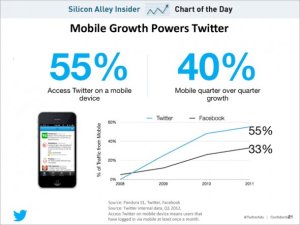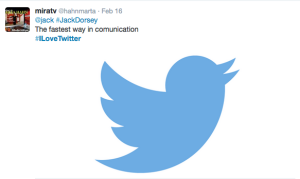Microblogging, as defined by Wikipedia, is “a broadcast medium that exists in the form of blogging. It allows users to exchange small elements of content such as short sentences, images, or video links.”
The most popular form of microblogging is Twitter. Twitter allows text updates up to 140 characters and can be associated with pictures or images. You can share your thoughts or the thoughts of others by retweeting, quoting someone, finding trending topics (which are topics that are heavily talked about in a short period of time such as the condition of Bobbi Kristina Brown), direct message, favorite a tweet, and use with links. Twitter is unique in the sense that it is useful for informing, performing interviews, getting in touch with people you are interested in following, for enjoying, re-tweeting, or sharing someone else’s knowledge. Even big-name newspapers use Twitter since its inception, such as the New York Times, The Onion, and The Wall Street Journal.  It has become such a widely used medium, that if you do not use Twitter, you are at a disadvantage. For example, Film and TV companies use Twitter to their advantage, as a way to publicize actors, actresses and their new releases. This is evident by being active with their with viewers and for added incentive, offer different prizes and giveaways.
It has become such a widely used medium, that if you do not use Twitter, you are at a disadvantage. For example, Film and TV companies use Twitter to their advantage, as a way to publicize actors, actresses and their new releases. This is evident by being active with their with viewers and for added incentive, offer different prizes and giveaways.
In terms of journalists, microblogging can help journalists and serve as a useful tool. In the digital era, it has become a necessity and it is getting their name out to their audience more than before. Microblogging serves as a great way to practice, find your voice, showcase your work, develop your niche, say what no one else wants to say… meaning that if you have no filter, you can actual write what you want to say, rather than what you feel you should say to an audience. Twitter is helpful in that sense because of the interaction and the ability of having the audience respond. This is seen through this short Youtube video:
Social Networks seem to be utilized in phases. There are ones that are more popular one year, and less popular a few years later, due to newer platforms being created and the evolution of the social network themselves. Since my generation essentially grew up with Facebook, we have started to grow out of it and now are starting to use LinkedIn more often. I don’t check Facebook as frequently as I used to and I know I definitely resort to other platforms first. As opposed to my parents who are now obsessed with Facebook and cannot leave the computer or phones! I think the obsession has hit their generation. There are different Social Networks that are useful for Journalists. So many new platforms are created daily, and it is hit or miss whether or not they become popular.
One Social Network that I believe would be beneficial and useful for Journalists, is “Bubblews.” I know what you’re thinking… why do I think this would be a great tool for Journalists? Bubblews is a content creation and discovery platform that combines the traditional social media model with unconventional leadership that allows users to profit from their posts. Have I swayed you yet? It is a holistic blogging platform and social ecosystem where users can express their opinions, meet those with similar mindsets world-wide, and be compensated for their contributions to the network. In fact, Bubblews serves more than 20 million visitors per month in 240 countries. This is an enormous amount considering the company was founded in 2012! 
Bubblews allows access to opportunities around the world and you are truly seen as an expert in an area that you love. The fact that you receive revenue creates potential to produce work that is clever, innovative and gives people a way to get themselves out there and their work seen. You are paid for every Like, comment and post that you received which is different from the more traditional sites and this payment will attract more and more new users. This is especially important for known journalists, and even struggling journalists. Journalism has become such a struggling field with the digital age that getting paid is essential to keep doing what they love. They may not get rich by doing this as they are paid only $0.01 per visit, but it can supplement their income approximately $2,000 per month for their time and contributions which must be a 400 character minimum.
Overall, this is a great Social Network for aspiring or struggling artists, journalists, or anyone with a hobby that feels like sharing their work. Since the digital era left journalists struggling and looking for work, Bubblews is a great outlet for those who want to keep updating their portfolio, doing what they love, and getting paid while doing it.

